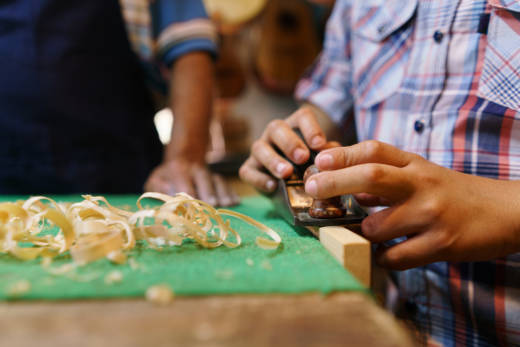“Like a theater production, there's sense of purposefulness," said Fine. "You're working toward producing something that has an audience beyond your teachers and your peers.”
SHARED SKILLS, DIFFERENT STRENGTHS
The challenge for teachers who want to tap into extracurricular engagement is to ensure students are learning the required curriculum while also making room for differentiation. Schools take different approaches to doing that.
One thing that is consistent, according to Fine, is that teachers are very deliberate beforehand. They have to know exactly what all students need to demonstrate mastery of and where they can allow students to move in their own direction.
In some cases, that means starting the class with core curriculum that all students study but branching off from there. One example Fine has seen is in a project-based humanities classroom. Students started the class by reading about the anti-communist fervor of the 1950s and McCarthyism. Then for the latter half of the semester, students were tasked with using the same rhetoric from that time to create documentary films on a controversial subject of their choice. Essentially, the project allows students to understand propaganda by making their own propaganda film.
At Clark Montessori School in Cincinnati, the last two weeks of each semester are devoted to project-based electives of the students' choosing. In courses like “Rockets and Roller Coasters” students design their own scale models of both, and visit military bases to see rockets in action and amusement parks for roller coasters.
“We let the passion of the kids and the adults drive the course and we make the academic ties as they come along,” said Clark Principal Dean Blase.
For junior high classes at Clark, field study is embedded into core subject areas as well. In social studies, for example, students learn local history and then study ethnography by interviewing residents in different neighborhoods and mapping those neighborhoods.
As Fine mentioned, all of this involves deliberate course design. When students go on field studies, they're not being handed off to some museum docent or zoo volunteer; the teachers map out what students are expected to learn and discover. The planning pays off.
“It is extraordinarily rare to have a discipline issue during a field study period,” said Blase. “I don't think I've ever seen a kid's head [asleep] on their desk.”
THE RIGHT PACE
While project-based learning can seem like the obvious way to engage students with core subjects, another important component is the pace of learning. For students to feel passionate about a project, they first have to feel competent enough in their skill sets to tackle it, something that can fall by the wayside in a traditional school calendar.
“Not everybody is going to learn at the same rate and the same way,” said Robbie Torney, a teacher at Lodestar Academy, a primary charter school in Oakland.
The day at Lodestar is broken into two parts: time for expeditionary and project-based learning, and a section of the day for literacy and math lab, where students learn core subjects at a personalized pace.
Most traditional schools teach students in a calendar-based curriculum model, meaning that at certain times of the year all students move onto the next step in curriculum. With that model, you get achievement outcomes that look like bell curves, noted Torney. But by letting students work at their own pace, they see huge gains in student achievement for all.
Torney says that teachers who guide projects in core subjects also have to be careful to make sure those projects have an impact in their students' lives. Teachers shouldn't just copy project-based curriculum from other schools without first making sure it fits with their community.
For instance, at Lodestar, kindergartners are learning about trash, which is a big issue in East Oakland. As the Black Lives Matter movement ramped up in East Oakland, ninth- and 10th-graders at Lodestar's sister school, Lighthouse Academy, did an expedition looking at power and social change (both schools are part of the EL Education network of schools).
“Instead of just writing a paper about power and social change,” they studied something local while integrating text they were reading, said Torney. The students had to present final products that covered the significance of these movements to the community.
A similar project took on a different angle at Polaris Charter Academy in Chicago, said Torney. There students studied the issue of violence in their neighborhood. Middle school students published a series of books, called the Peacekeeper Project, which documented the work of peacekeepers in their community.
Whether you call them expeditions, field studies or project-based learning, “the idea is that there's a product that is high quality that allows you to demonstrate mastery,” said Torney.
They are learning core curriculum in a way that gets them highly engaged, but there's even more payoff than engagement, said Torney. The bigger outcome happens when students are in college or starting their careers.


